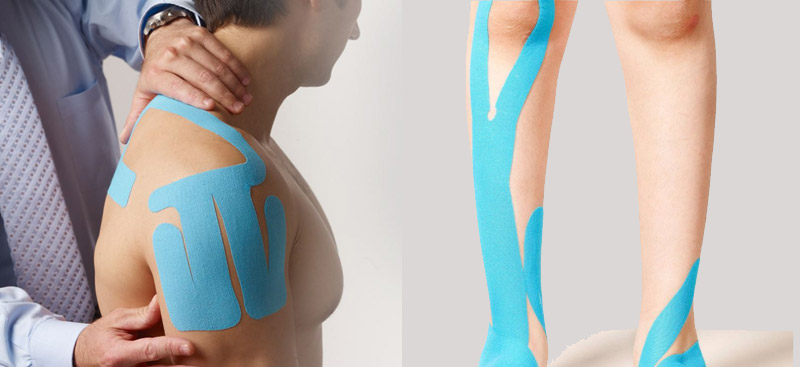Although typically thought of as strictly within the realm of athletics, kinesiology taping actually has plenty of non-athletic centered uses for the everyday individual that can provide some great benefits. Plenty of studies have been done on the pros of kinesiology taping for relieving muscular pain, general muscular improvement, and improved healing abilities.
Kinesiology Tape Basics
In order to understand the benefits of kinesiology tape outside of athletics, it’s equally important to have a basic understanding of how the tape works.
When applied correctly to an area, the tape works through lifting the skin away from tissues underneath; these tissues are filled with muscles and connective tissues, which the tape affects through compression and decompression, which results in altering the signals sent to the brain. It also helps improve lymphatic flow, which prevents swelling.
The tape’s elasticity plays a vital role in this process, as it allows for increased or decreased tension to be applied to the affected area. Internally, this causes contractions and de-contractions, which, for example, can help strengthen muscles post-surgery or help reduce muscularly and back pain by altering pain reception.
Muscle Relief
Everyone suffers from some form of muscle pain; it isn’t just limited to athletes. Tension and soreness within the muscle can be a major obstacle to many trying to go about their day, causing discomfort and, in some cases, major pain that can hamper a person’s ability to perform tasks and work. Thankfully, kinesiology taping can help on that front.
Across numerous studies, kinesiology taping has shown to relieve muscle pain and tension after set amounts of use, greatly improving motor functions and the ability to operate effectively. The tape works through creating a lift for the muscle sensory receptors that are responsible for transmitting pain signals to the brain. It works to decompress those receptors, causing the sent signals to change and the brain to react accordingly; this, in turn, helps to relieve the tension and soreness attributed to muscle pain.
Kinesiology taping can also be used as a way to provide therapy to damaged or long unused muscles; studies have even shown kinesiology tape as a way for stroke patients to improve their ability to walk. It’s generally believed that the feeling and presence of the tape within the affected area makes you hyper aware of it and consequently the area itself, focusing your mind and providing increased awareness of how you stand and move.
Upon application, the tape is typically used for three to five days; the tape is durable enough to allow you to shower with it and by using it, you can improve and optimize how the specific areas of your body operates. However, you shouldn’t rely too much on the tape, as your muscles might come to rely on it as well.
Inflammation Reduction
When a muscle is injured or strained, then this can cause a build-up in lymphatic tissue as the muscle compression prevents proper flow. This, in turn, can result in the build-up of fluids like lactic acid, which is one of the core causes behind muscle soreness. By applying kinesiology tape to the necessary area, the tape works to reduce the aforementioned compression and, therefore, pressure, which allows for proper lymphatic flow and draining of lactic acid, which builds up often in injured areas.
Additionally, kinesiology tape can also be used to help reduce swelling and inflammation post-surgery and for those with ailments that cause severe inflammation like lymphedema. It can even help with chronic inflammation.
Overall Functional Improvements
Thanks to multiple studies, kinesiology taping has been shown to help improve muscular function, which is a key component in the healing process of muscles. For example, a 2016 study found that 30 elderly patients suffering from degenerative knee arthritis experienced both reduced pain and stiffness and improved knee joint function and increased motion range after four weeks of using kinesiology tape. Additionally, another 2016 study and a separate 2017 study found similar conclusions concerning the improvement in muscle flexion and motion range after using kinesiology tape.
Minimal Side Effects
One of the best parts of using kinesiology taping outside of athletics is that tapping doesn’t come with the same side effects commonly found with standard prescription drug use. Kinesiology tape helps provide muscular support without restricting any motion range; this means that you can stay active without worrying about exacerbating your injuries and letting them heal normally. Additionally, there is no real limit to how long you can wear the tape, allowing you to wear it over 24-hours for several days per tape application


